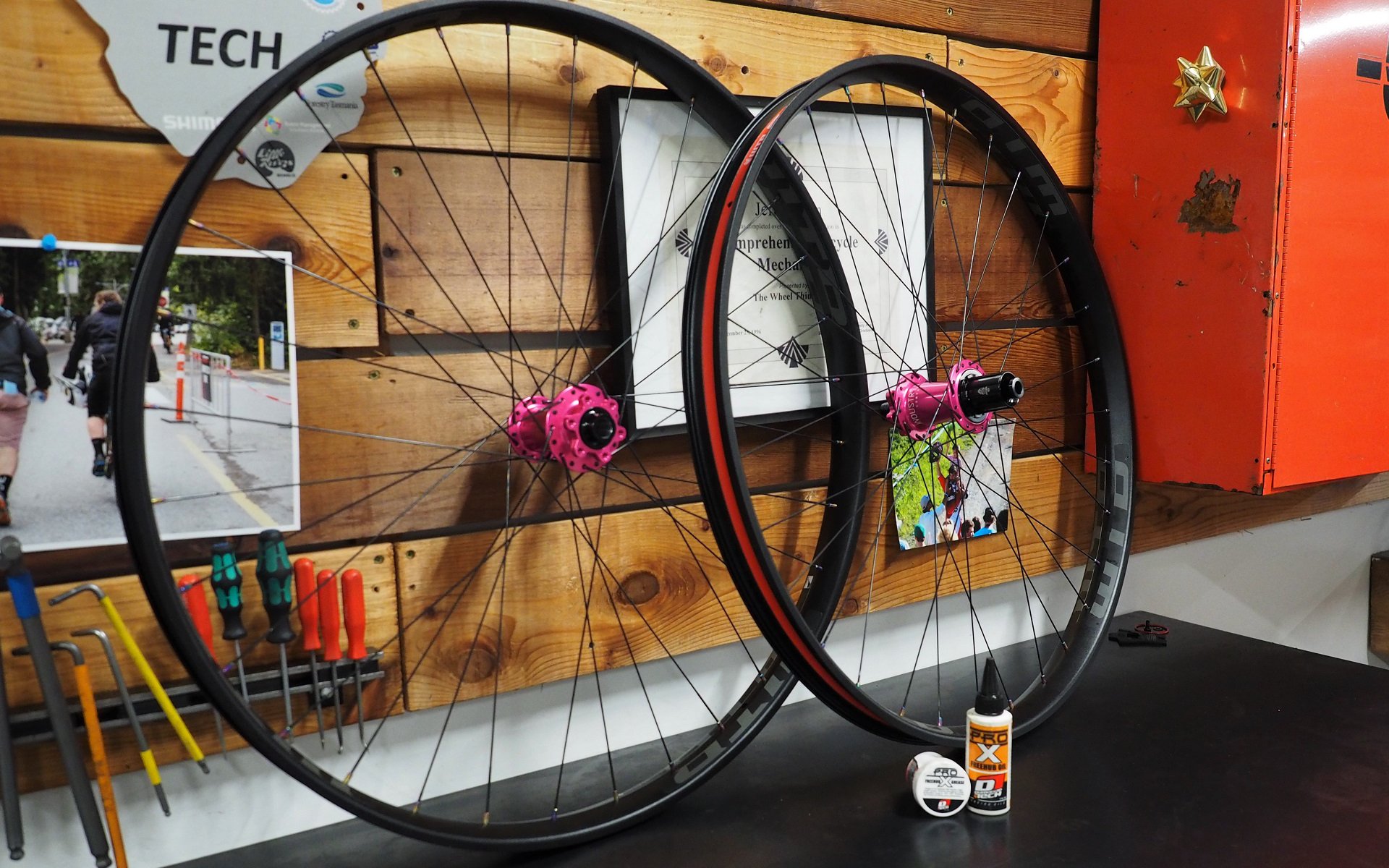
Teardown | First Impressions
Industry Nine Hydra Hubs - Ridden
Occam Meets Instantaneous
Reconciling the guts of the new Industry Nine Hydra hubs with my first Shore-XC ride is an interesting exercise. When I pulled the freehub body off the anodized pink hub shell, six steel pawls looked back at me. At a quick glance, the only major difference between the Hydra and the Torch hubs I've ridden previously are the leaf springs pushing the pawls into position instead of the coil springs of past models. On a closer look, there are larger bearings, squarer shaped pawls, and a much toothier drive ring - but no surprises.
The first thing I notice that really sets the hub apart from previous Industry Nine hubs, and other pawl hubs in general, is the sound. The closest comparison I've ridden is Chris King's famous angry bees. The sound of these Hydras has been damped by adding some Dumonde Tech freehub grease to the mix but those that prefer screaming loud hubs can just run Dumonde Tech's freehub oil.
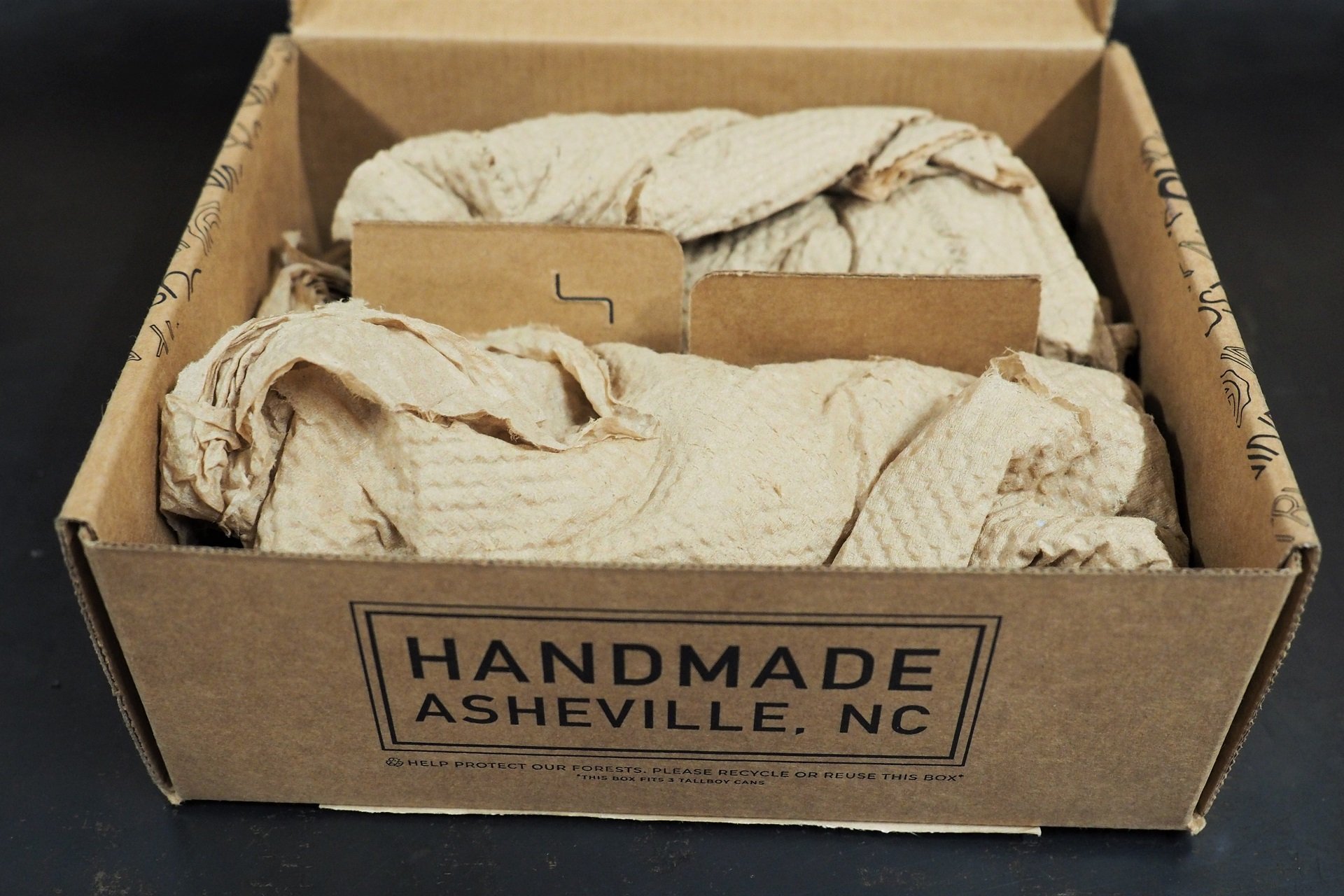
Industry Nine has reduced its foam use by 90% by using recycled paper to packaging its hubs. I can think of a lot of companies in the bike industry who need a Morgan in shipping.
These sound very different from other pawl hubs and when I give the pedals a tap the engagement is so fast it might as well be instant. Zip. Industry Nine calls it 0.52° engagement but it doesn't feel any different than putting the power down on the True Precision Stealth hubs. There is no lag.
True Precision hubs use an industrial INA roller clutch mated with a heat-treated stainless steel driver, Chris King hubs use their signature spring-loaded drive & ring system, and Industry Nine's approach looks a lot like other high-end pawl-style hubs I've pulled apart.
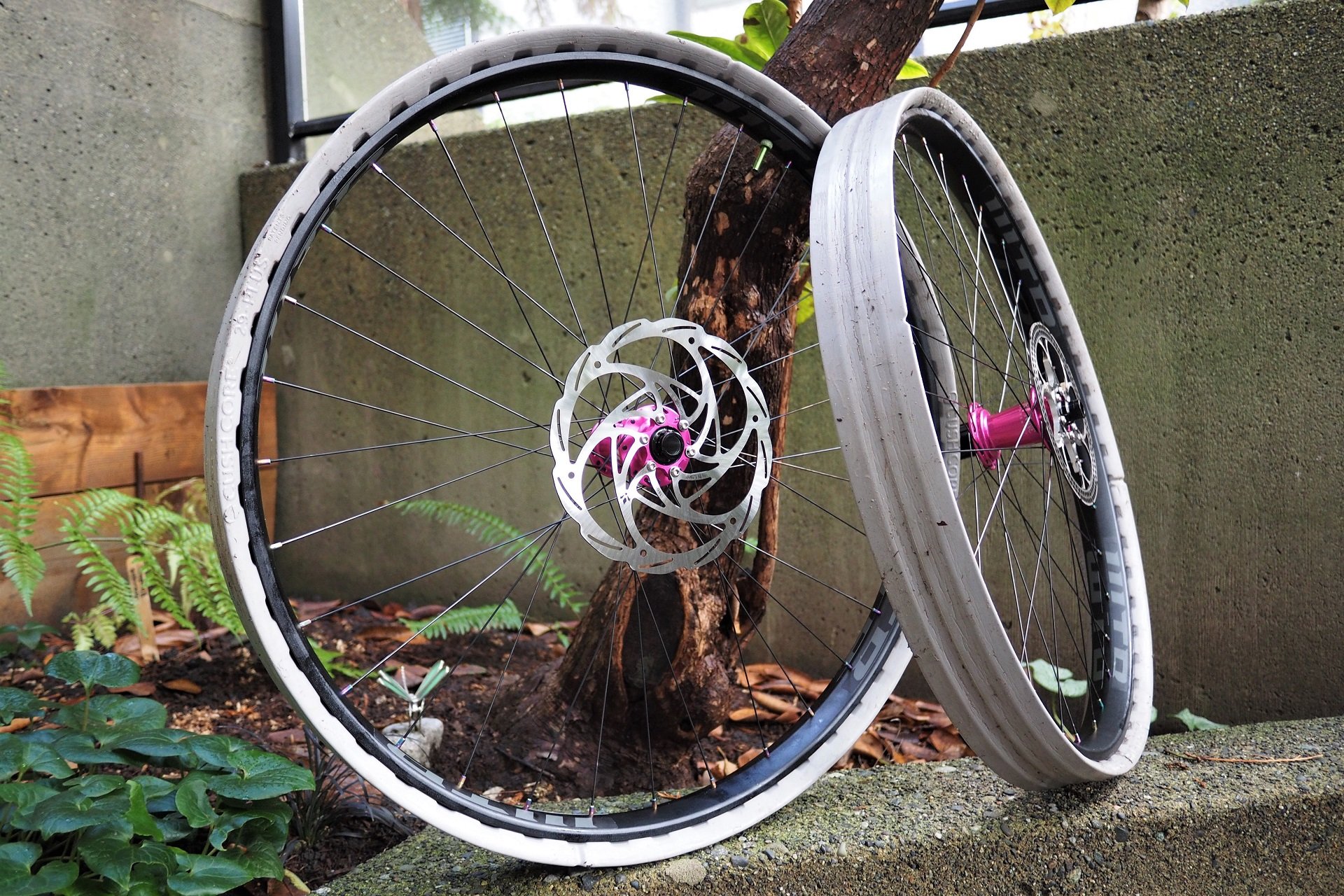
I run big rotors, CushCore Plus inserts, and 29 x 2.8" WTB Tough Casing tires mounted on WTB KOM rims (Light front / Tough rear)...
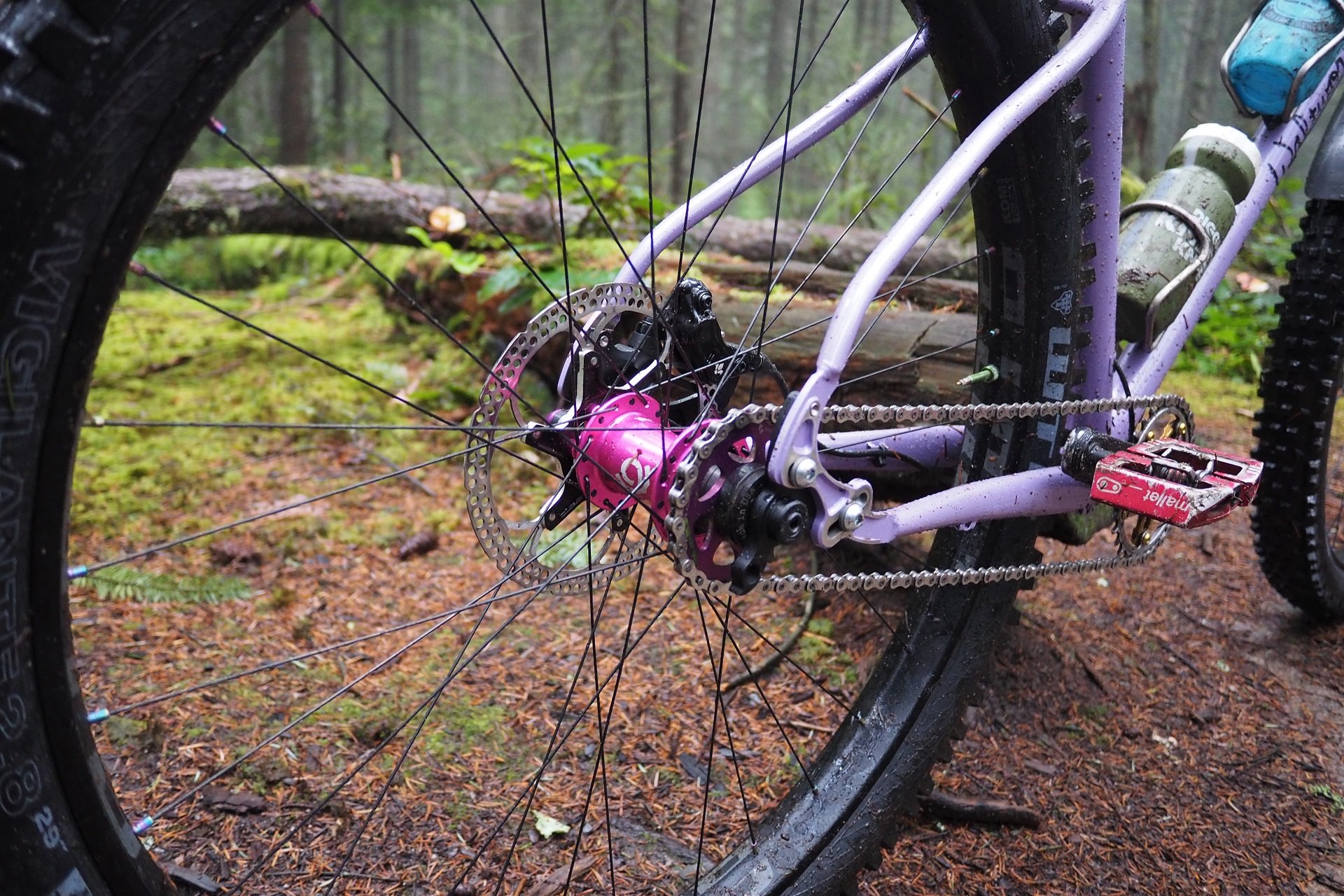
...so when I'm standing to grind up a climb the Hydra system is being asked to rotate a lot of traction and plenty of mass.
The 'how' is the simple magic of the system. Take six pawls, mate them to a 115-tooth hardened steel drive ring, and then design the system so one pawl hits at a time for 690-points of engagement or a click every 0.52°. Then that single pawl acts as a fulcrum and as the drive system loads up another one, two, or three pawls can engage as well to support it. Basically the harder the system loads the more support that pawl gets from its squad.
It's early days but I've cranked the Hydras up some of my favourite local climbs - frothing at the mouth and turning 1688 grams of rubber per wheel - and everything has been instant and smooth.
Open It Up
There are two distinct takes to bearing adjustment on cartridge bearing hubs. Some, like Project 321 or True Precision, use an adjusting collet to dial in the tension. In theory, this can make for perfect loading of the hub assembly but they can come out of adjustment. Any mechanic will tell you folks often run the hubs over-tensioned to combat this, which isn't great for efficiency or bearing wear.
With hubs like the Industry Nine Torch & Hydra or Race Face's Vault, the bearings are tensioned against an internal spacer when my frame's rear axle is tightened. As long as the rear axle of my bike is tight, my hub is tensioned. I've used great examples of both, and I've also had collet hubs that came out of adjustment constantly and axle-tightened hubs with bearings that blew out prematurely or poor tolerances that led to an unacceptable amount of drag in use.
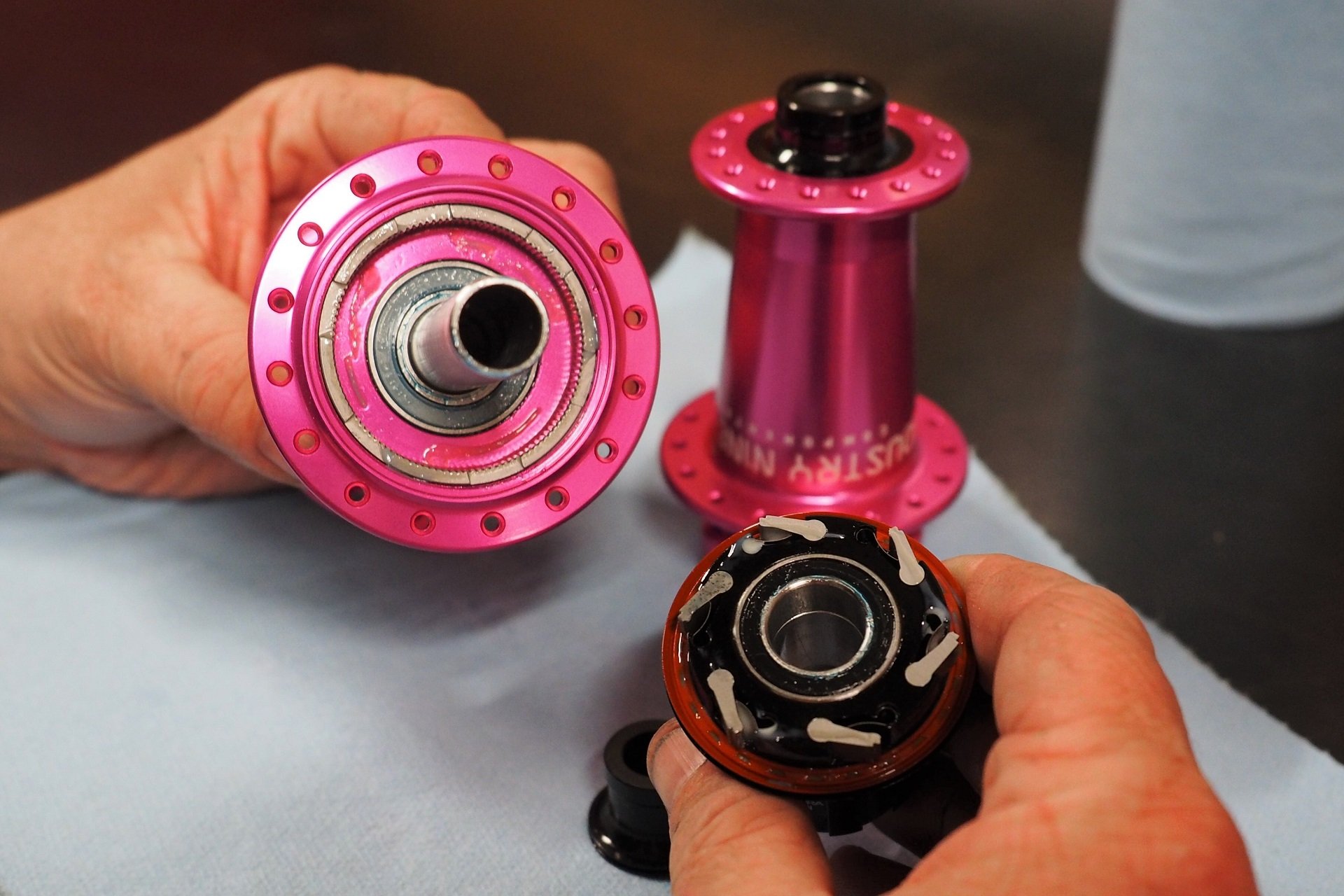
Six pawls engage one at a time with a 115-tooth steel drive ring to deliver 690-points of engagement.
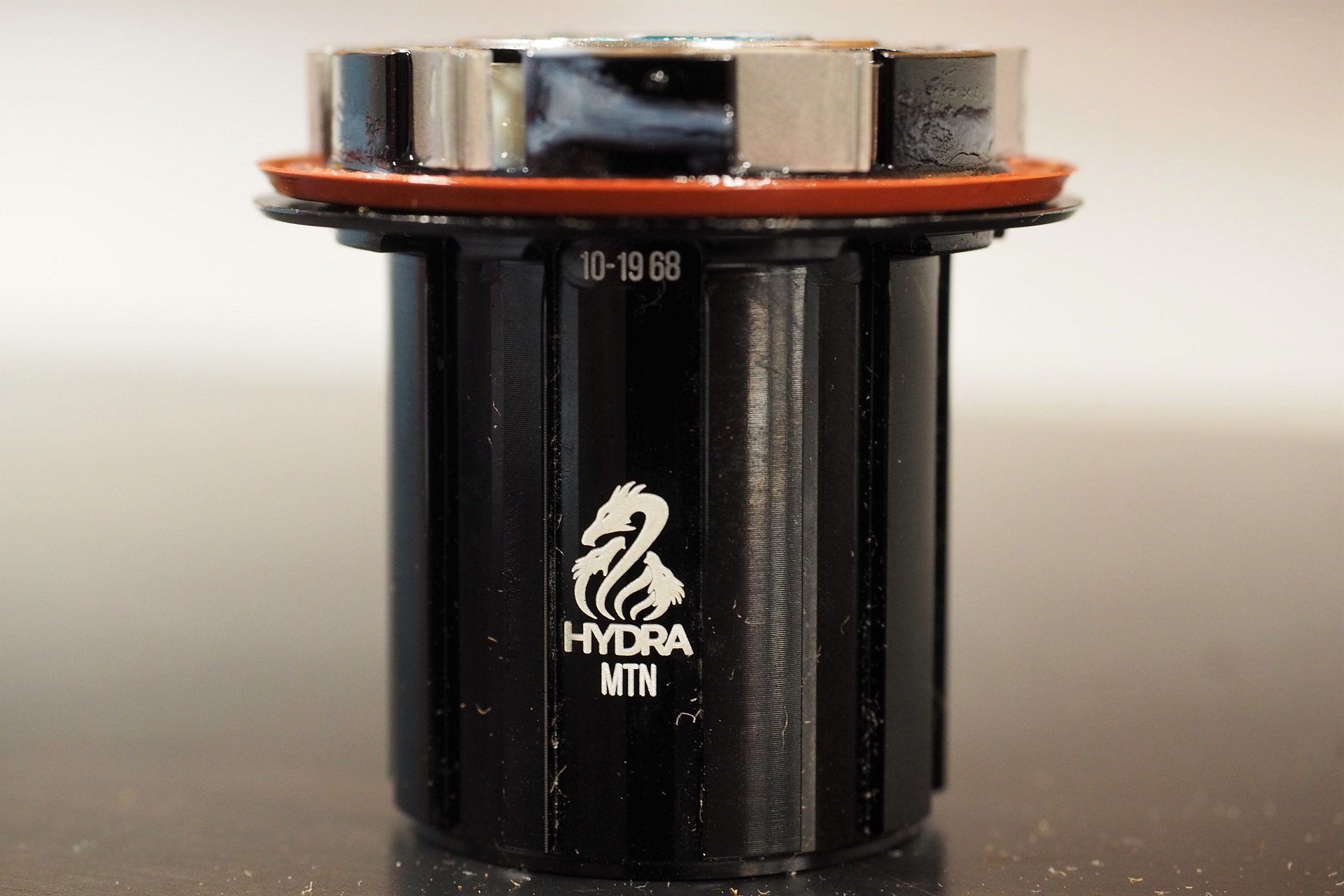
Micro Spline, XD, or good old HG; Industry Nine covers all the current freehub options. Swaps are tool-free.
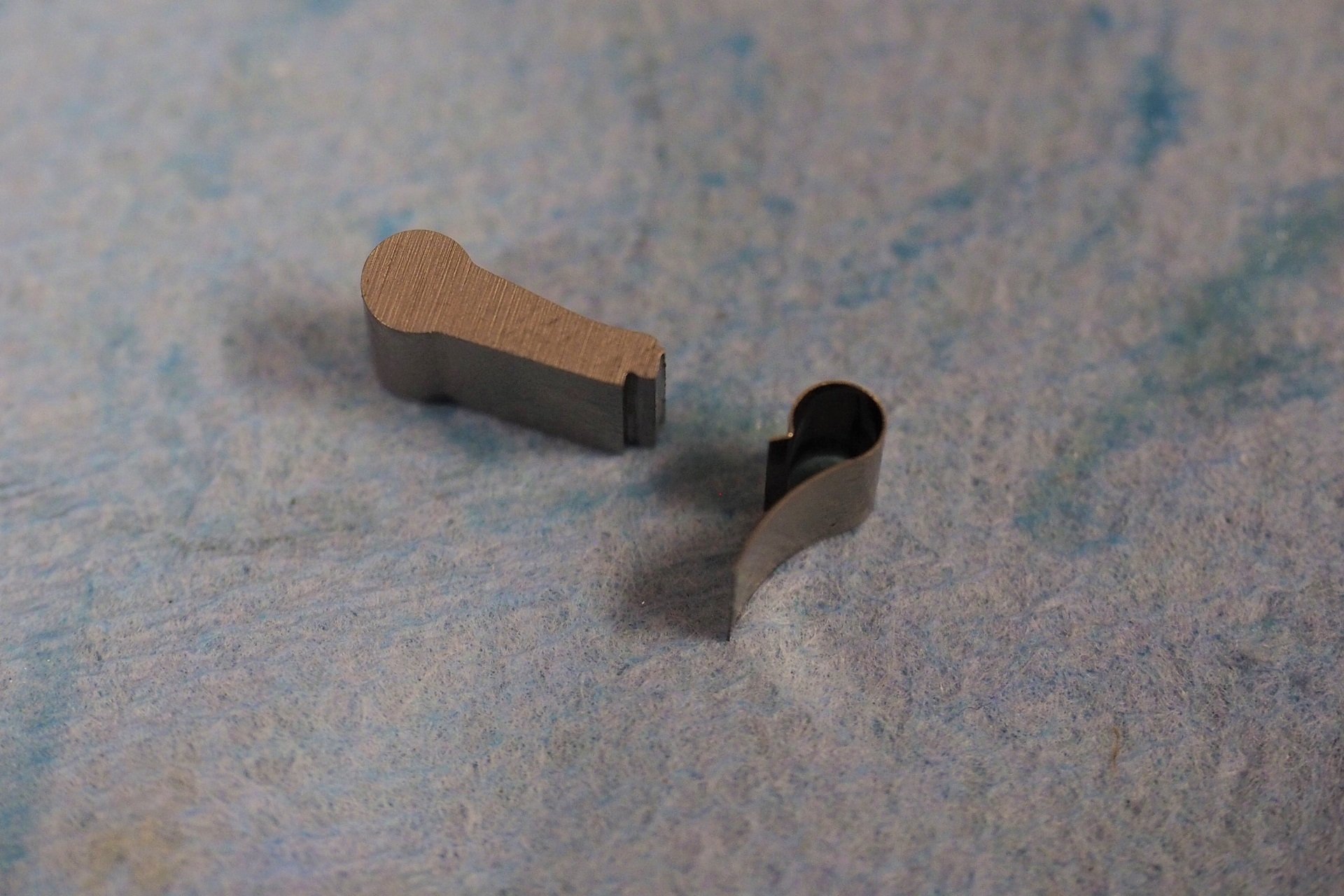
Steel pawls and leaf springs. Lube them with Dumonde Tech freehub lube or for a quieter experience add in some Dumonde Tech freehub grease.
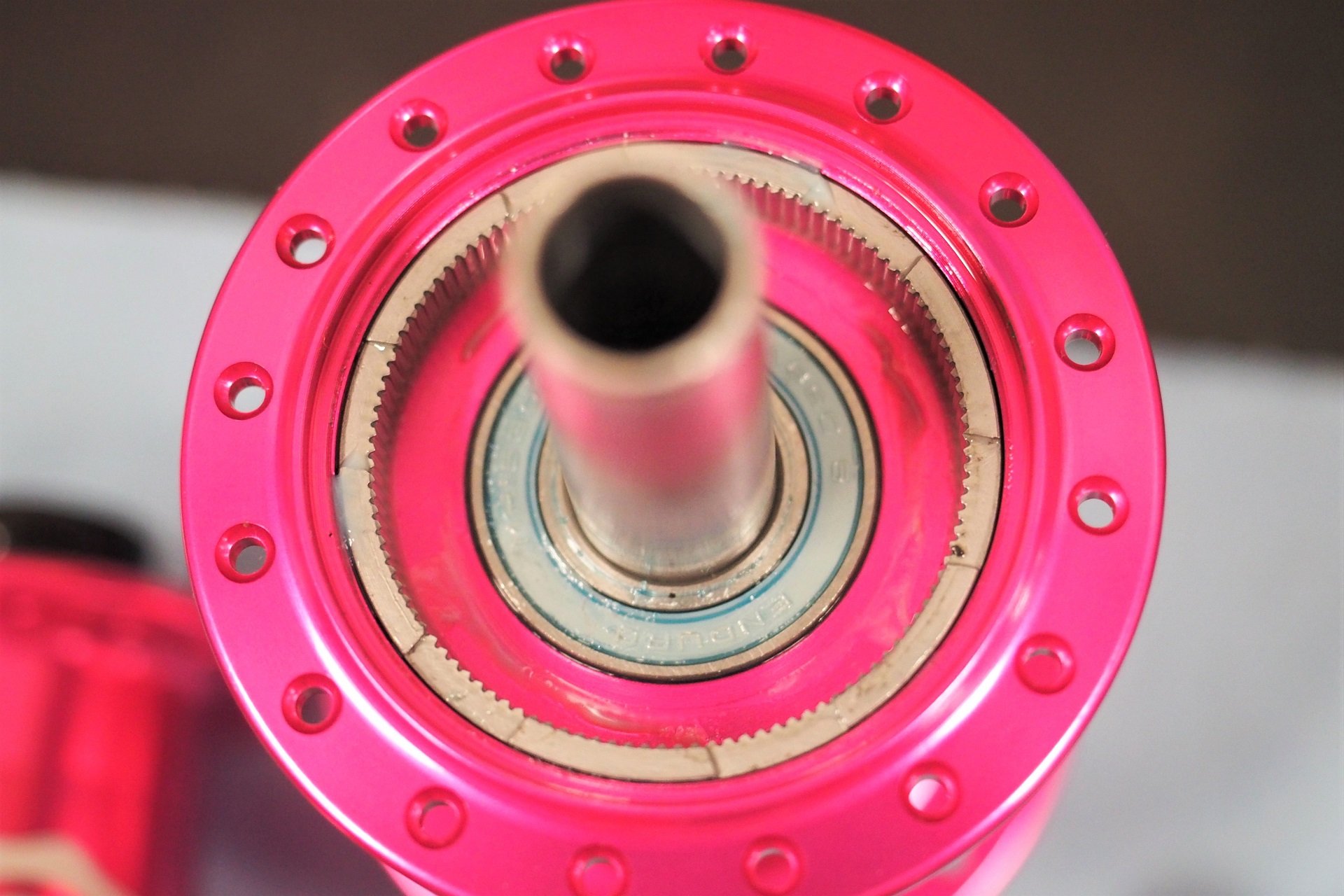
The 115-tooth drive ring is the only part of the hub that requires a proprietary tool to remove and the vast majority of riders will never need to replace it.
Through multiple frames, I never experienced any issues with bearing tension with the Torch hubs. I ended up replacing the large drive side hub shell bearing a couple of times. As with any service on an Industry Nine hub, it's relatively fast and simple to do.
Hydra steps down the outer diameter of their thicker axle so they can enlarge the size of their hub bearings. Add in a nice upgrade to Enduro's ABEC-5 level bearings and it will be interesting to see how bearing life compares.
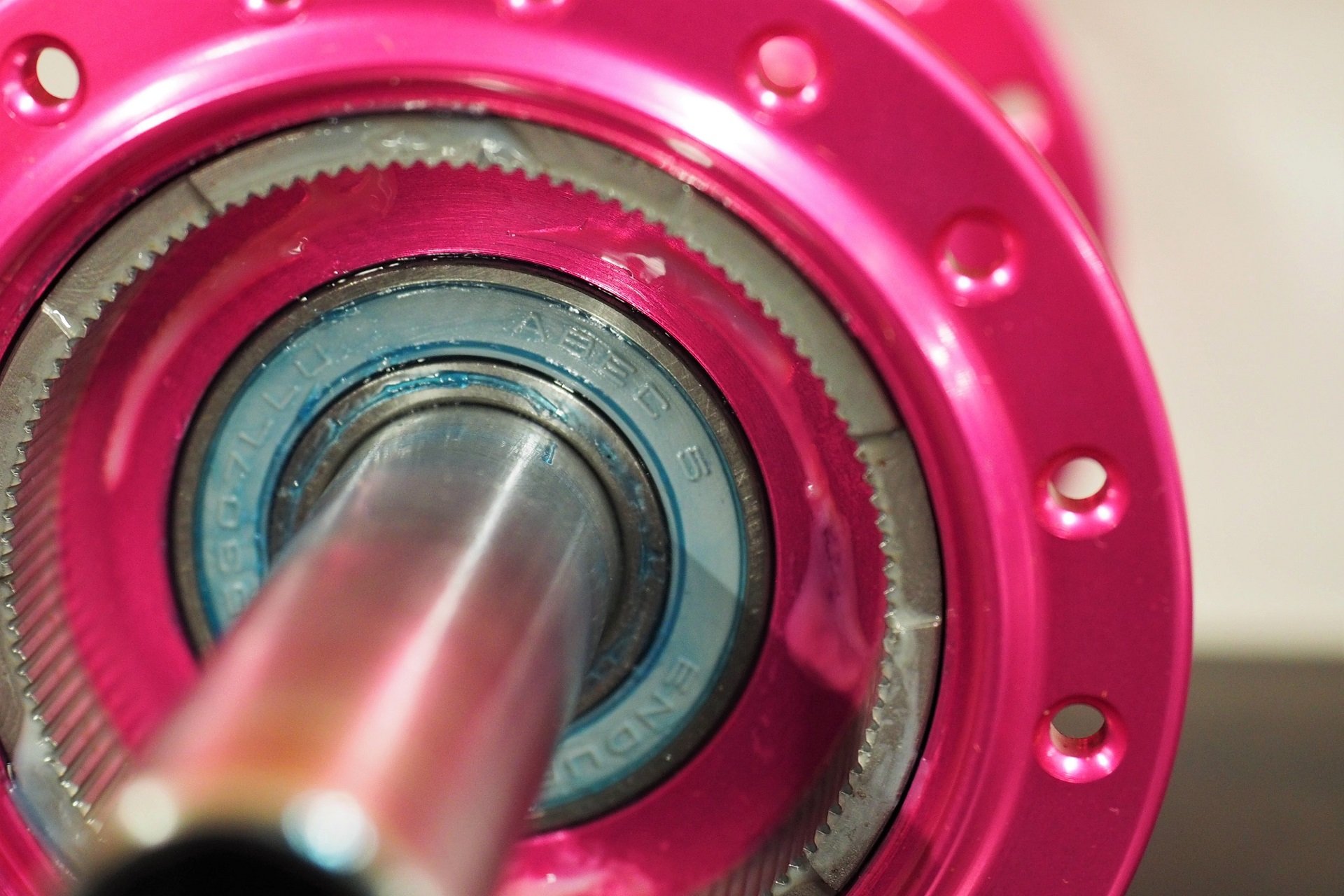
Hydra gets smaller OD axle without a machined out internal wall which makes for a thicker & stiffer assembly and room for larger bearings.
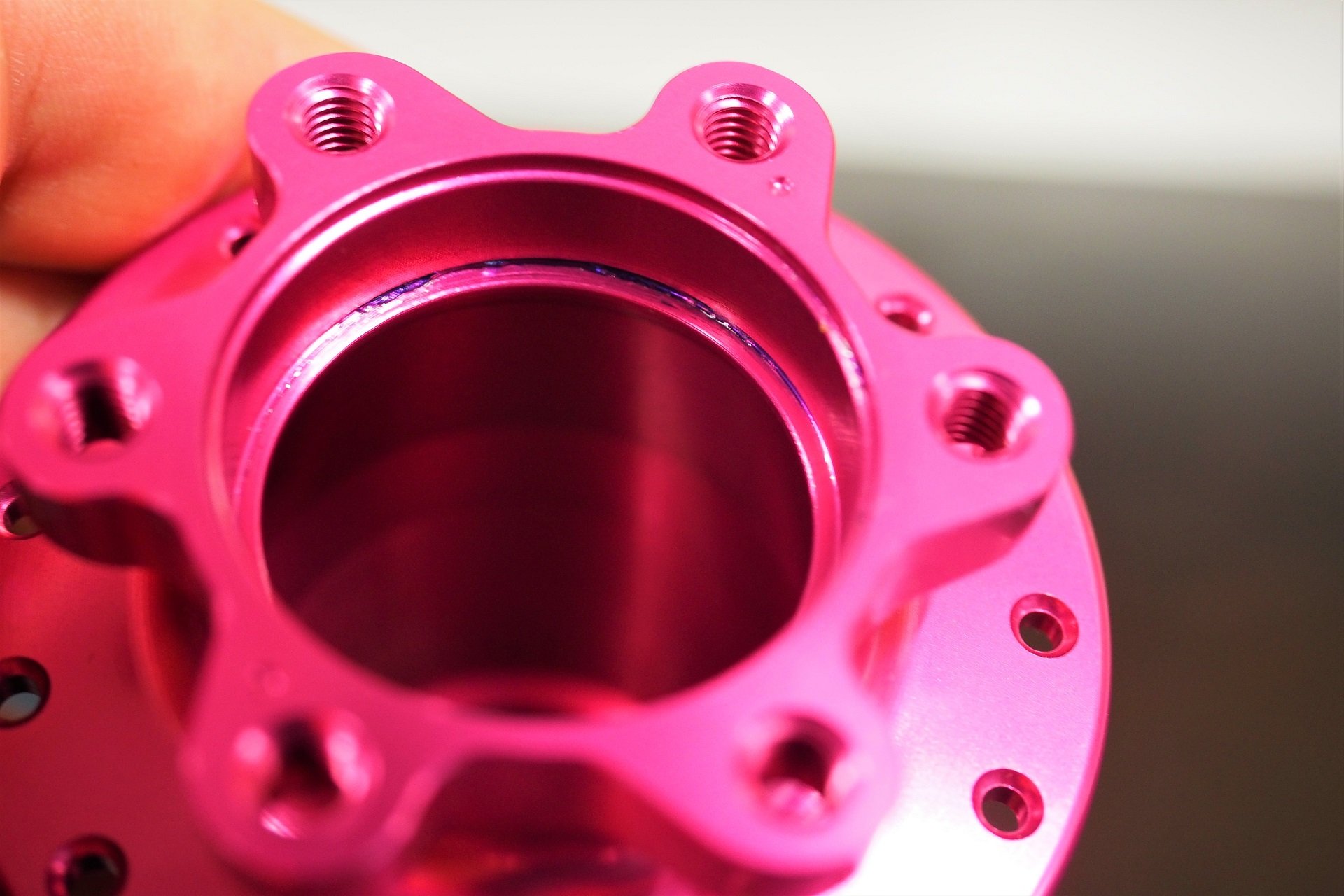
Two schools of thought on anodized bearing journals. Manufacture them to size and then go through the time and expense of post-machining the anodized shell - which is hell on tools - or dial in your anodizing to add exactly the right thickness.
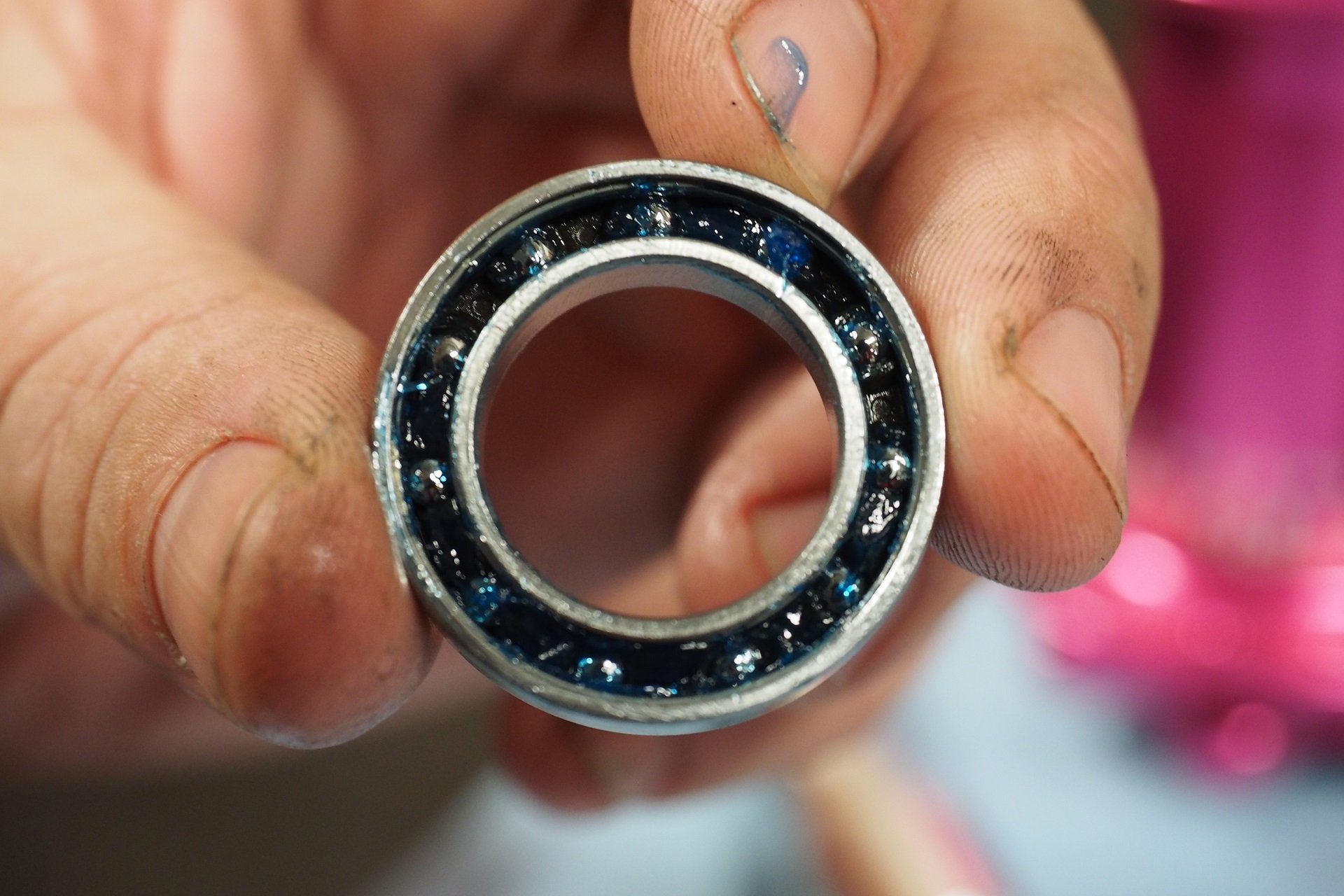
The stock bearings come well packed with grease. XC-Race types may want to run something lighter, riders who shuttle may go for something heavier, and this is a happy medium.
As to the drive system itself, the theory holds that in addition to engaging much faster Hydra should also prove more durable with more pawls engaged under load. The leaf springs aren't susceptible to gumming up like Torch hubs' coil springs and they deliver enough force to drive the pawls fiercely into the seats in the drive ring.
Torch hubs performed best with Dumonde Tech's freehub oil, or mineral oil, and even properly lubricated they screamed loudly. Thanks to those leaf springs, the Hydra can be run on oil or some Dumonde Tech freehub grease can be added to dampen the sound. I like quiet hubs and these Hydra's are running as quietly as anything I've ridden aside from roller clutch hubs. They produce a zippy little high pitched whine.
In theory, the hub may need a bit more upkeep than more heavily sealed, higher drag, systems but the tool-free act of pulling off the freehub bearing is brainless and a full clean and lube is barely worth opening a beer over.
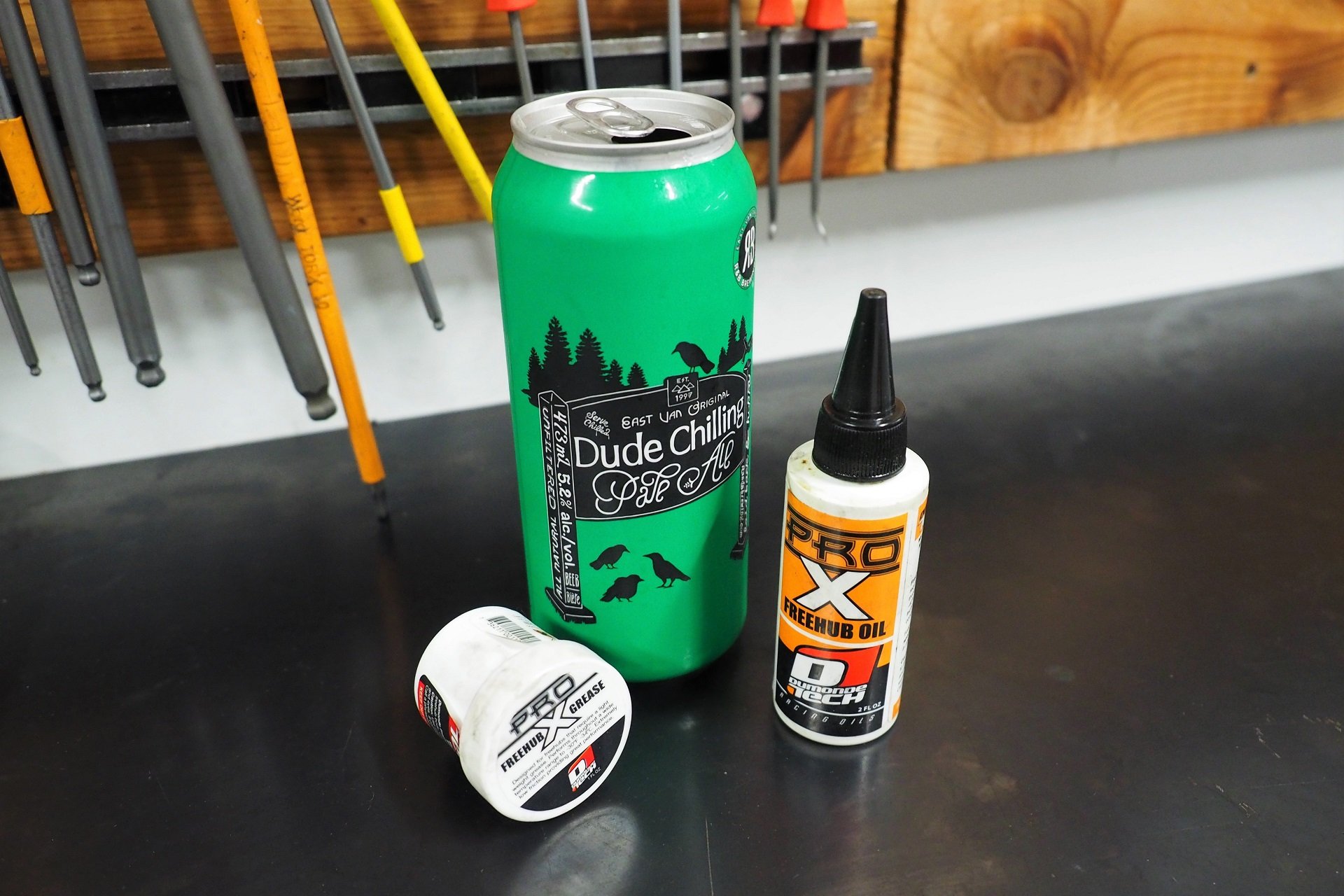
Nice selection of lubricants. Dumonde Tech is the one constant in all the pawl-style hub teardowns Jeff and I do.
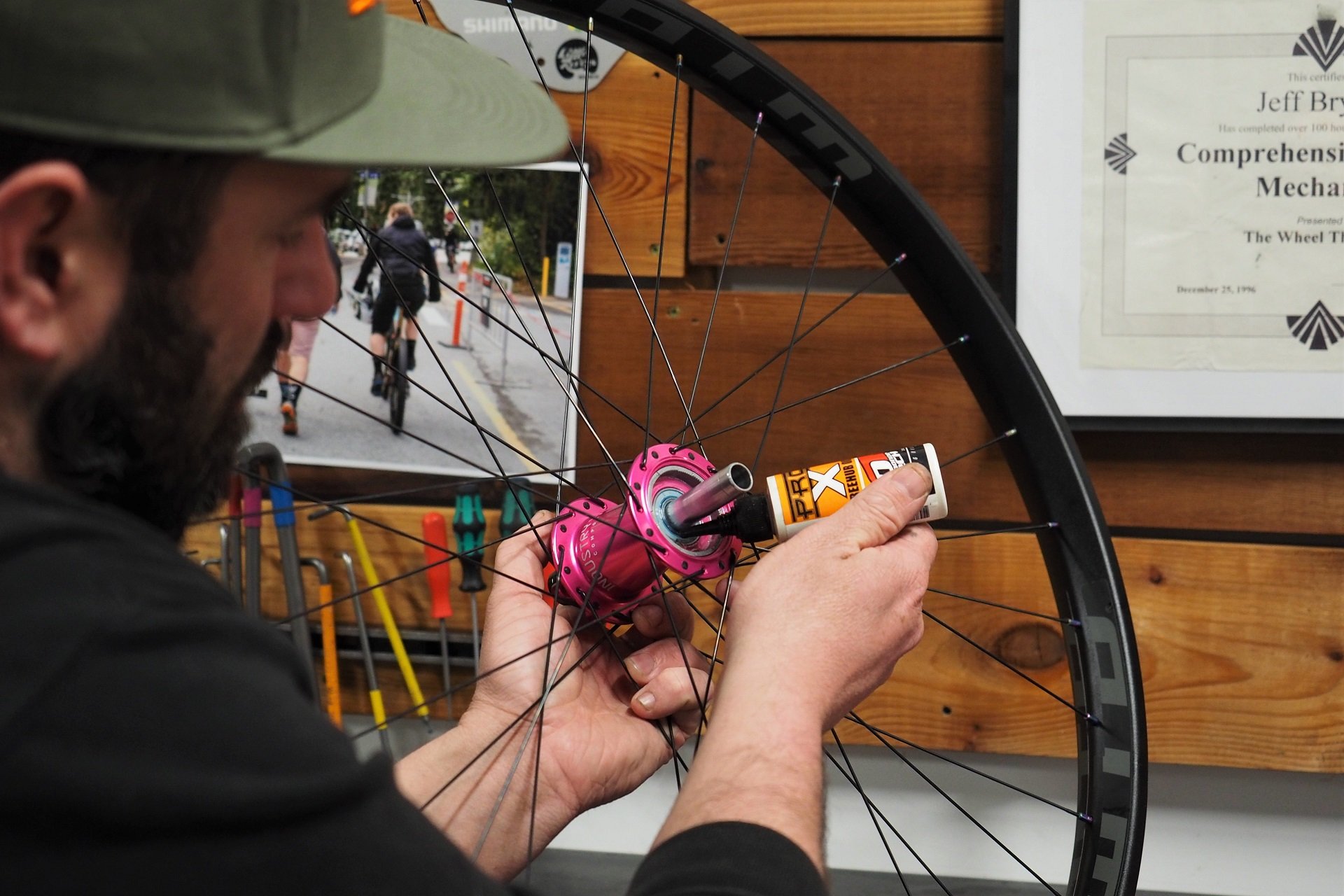
Dumonde Tech freehub oil is The Best option for most pawl hubs - I've run it with Mavic, Race Face, Sun-Ringle, P321, Formula, and Industry Nine.
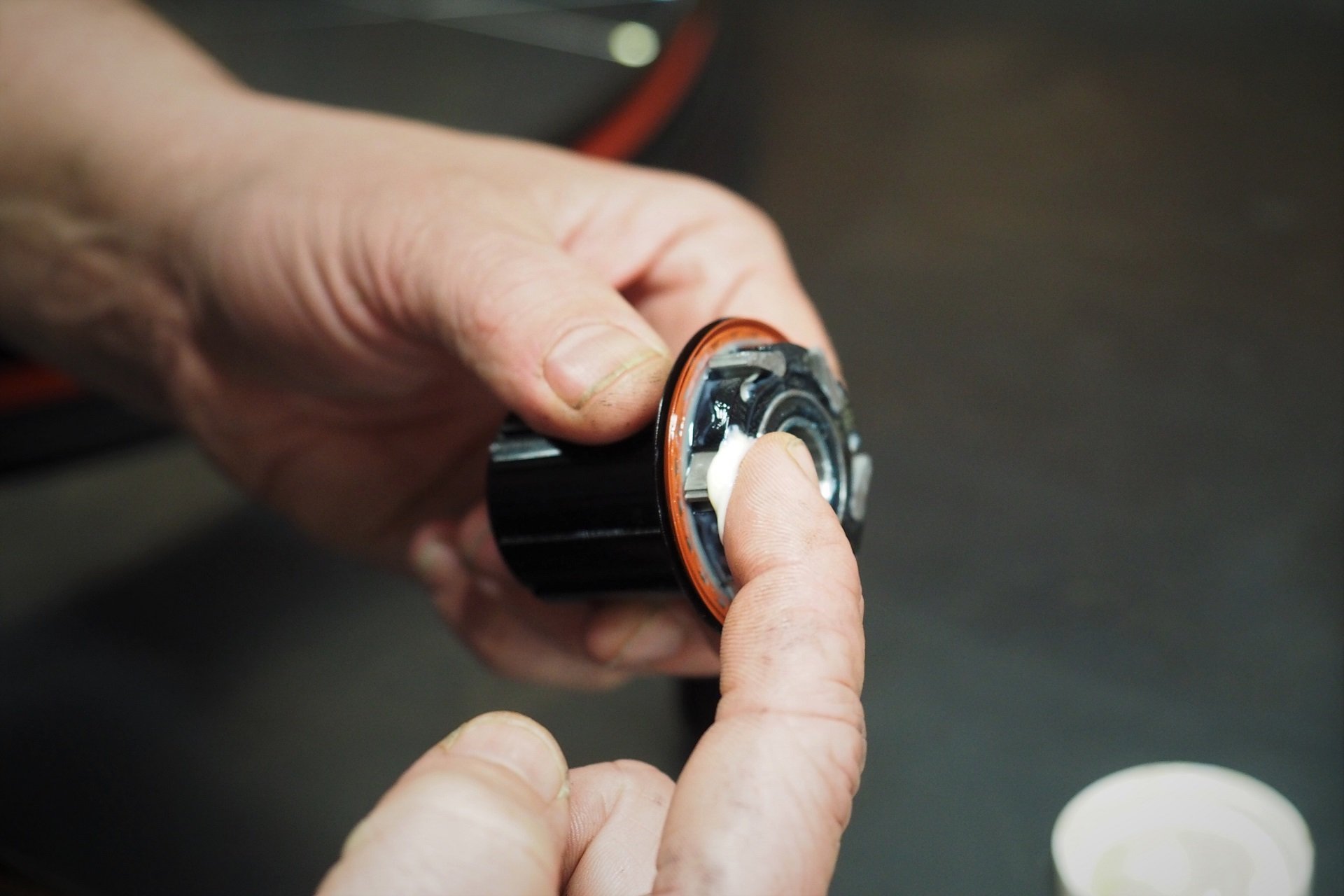
On pawl hubs like the Hydra that will accept it, the Dumonde Tech freehub grease adds a degree of sound damping that I prefer.
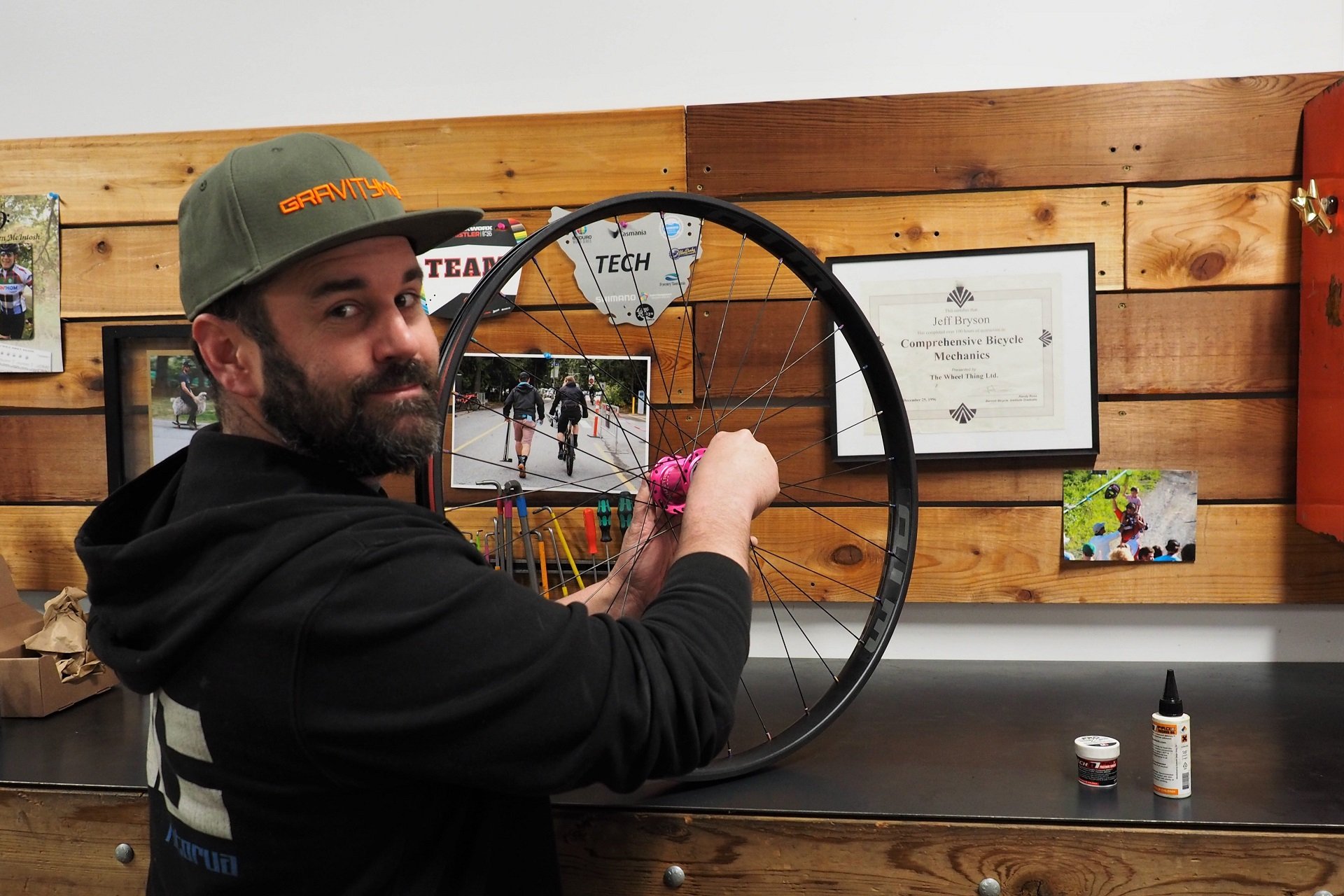
Jeff giving the freehub a spin to make sure it's smooth-as. In my hands I can discern the 0.52° clicks but on the trail it feels instant.
I'm not really interested in litigating whether super-high engagement hubs are necessary. If you're happy with 20°, 10°, 7°, etc. that's great. Especially on my hardtail, the faster a hub engages on technical climbs the better so I'll take near-instant feedback with 690-points delivering 0.52° of engagement.
The potential magic in Industry Nine's Hydra is that near-instant engagement is achieved without a heavy, complicated, or difficult to service system. An added bonus is the drive system should be more durable than the already solid Torch setup thanks to the 6x independent pawls acting as a squad. Early days, but the system hits fast, runs low drag, and sounds pitch-perfect.
I've had nothing but positive things to say since Jeff and I did the teardown and my friend Dumpster-Bear laced the wheels up. I'll hammer them all winter and report back.
The rear sells for 435 USD, the front sells for 215 USD and they're available in eleven colours. For more information check out Industry Nine.
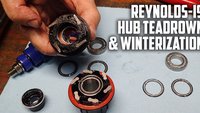
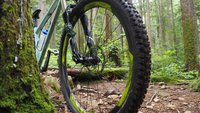
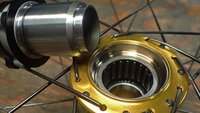
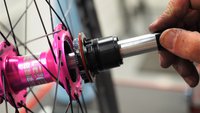
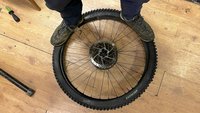

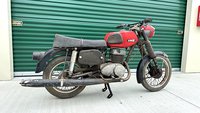

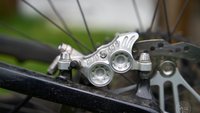


Comments
ManInSteel
4 years, 4 months ago
Another steel hard tail by Walt?? Please...That beauty deserves a full shot.
Reply
fartymarty
4 years, 4 months ago
https://www.instagram.com/p/B58qLTNHeCX/
Wow, we definitely need more piccys. It looks amazing.
Reply
Andrew Major
4 years, 4 months ago
Thanks guys! Walt V.2 is something that had to happen or my brain would have exploded.
It’s really cool to sit on so I’ll try and add a cockpit shot. 64-HTA, 31mm stem, 16-back SQLab bar with a ~1250 wheelbase (~460mm stays) as it currently sits so the riding position is very different and I really like the weight balance. Sort of like riding a well proportioned rigid DH bike if that makes sense.
Semi-gloss metallic ‘Cosmic Lilac’ powder turned out better than expected!
Reply
Vik Banerjee
4 years, 4 months ago
A full article! :)
Reply
Eric Van Sickle
4 years, 4 months ago
Once you installed the Dumond grease, how was the noise level to the quiet P321? I really like the P321 for how quiet they are and don’t want a loud hub.
Thanks
Reply
Andrew Major
4 years, 4 months ago
It depends on what pawls you run in your P321 hub. I’ve been running mid-volume pawls with sleeved magnets with just Dumonde Tech oil and, while it’s a different sound, they’re in the same volume ballpark as the Hydra with a grease/oil slurry.
The original P321 ‘quiet pawls’ with oil is a bit quieter setup.
Reply
Eric Van Sickle
4 years, 4 months ago
Thanks for the reply. I have the “older” quiet pawls. They are almost silent when clean and fresh oil and make a small amount of noise when used for a while. I’m not sure I could go back to anything louder as silence is bliss.
Reply
Andrew Major
4 years, 4 months ago
I was thinking about this on my ride today and due to the pitch the Hydra is almost unnoticeable with the freehub grease slurried in (certainly quieter than my tires) but in absolute terms, the P321 with the original quiet pawls is as close as you can get to the True Precision Stealth hub (or Onyx) without going to a clutch design.
Silence is bliss, and I'd certainly put the Hydra in the same category of 'not annoying' but at the same time 'not an early warning system for other riders/hikers' so pros and cons as always.
I'd be surprised, once a bit of the grease is in there, to hear anyone complain the Hydra is too loud.
Anyways, just wanted to make a more definitive post.
Reply
oudiaou
4 years, 4 months ago
Thanks Andrew for the review and extra info. May I ask for another comparison - how does their volume and drag compare to Shimano hubs? Of course, Shimano hubs are much criticized and far from being high engagement, but I appreciate their low volume... thanks!
Reply
Andrew Major
4 years, 4 months ago
Declaring my biases (multiple), I've serviced enough Rainvoucer-ridden cup & cone hubs in my life thanks. For mountain biking, you won't catch me on Shimano hubs by choice.
I'd consider some classic DuraAce or Ultegra hubs for a really nice high-end, fair-weather, N+2, custom steel road bike (we're talking rim brakes here - no doubt) but if I had that kind of bike budget an R45 would be an easy sell.
That said, I haven't so much as seen the newest performance-level Shimano mountain bike hubs in person so I can't give any specific feedback there. Shimano's high-end road hubs are quieter than Hydra but I'd say for that application it's higher on most riders' desirability lists than even moderate (<10°) hub engagement.
All the DT Swiss road wheels I've worked on have had the stock 18t ratchets installed (20°) and King's R45 hubs gave up engagement to reduce noise and initial drag over their classic/mountain hubs (45-pts VS 72-pts) so if you don't care about engagement then I think there are plenty of quiet-and-awesome options for those happy with limited engagement vs. noise/drag.
BUT...
The exception is truly budget bikes where Shimano basically gives away Center Lock hubs with brake packages. It really fists customers into limited rotor choices, or expensive adapters, to get away from their 'Resin Only' crap but otherwise, I don't have an issue with CL and let's face it they're probably the best - at least rear - hubs I'm getting on a budget bike (especially Boost).
I recently have hours on the MT400 hubs (front/rear) and if you can get over the lack of engagement they were engaged solidly once I hit the engagement point and they were very quiet (less noticeable than Hydra). So maybe that's helpful.
Sorry!? Can’t talk about Shimano hubs without ranting a bit.
Reply
oudiaou
4 years, 4 months ago
Hi Andrew, many thanks for the reply! I understand the rant - asking about Shimano simply as point of reference noise-wise.
Reply
Andrew Major
4 years, 4 months ago
Ha, yeah - sorry about the rant!
[user profile deleted]
4 years, 4 months ago
This comment has been removed.
Andrew Major
4 years, 4 months ago
It’s early days, but I’m very impressed how instantaneously & solidly they hook up.
The concept of the one pawl leveraging the system into action was admittedly something that I was having a hard time picturing until I looked at the drive ring and saw how close multiple pawls are engaged at any point in the cycle. If anything single speeding may be better for the system since under power it’s always fully loaded!
And yeah, micro-ratcheting doesn’t even fully describe it!
Reply
Jerry Willows
4 years, 4 months ago
How does the hub compare to others in regards to rolling resistance. To me, this is far more important than degrees of engagement or noise. Roll faster = better.
Reply
Andrew Major
4 years, 4 months ago
Great question. Fresh out of the box I’d compare it really favourably to the Project 321 which is the most efficient hub I’ve used. Certainly when I spin the wheel it goes-and-goes.
I could definitely be convinced to buy the Japanese made EZO bearings P321 uses as a future upgrade when bearings are needed.
Maybe more importantly, it’s super easy to keep clean (no tools required) so a bit of routine maintenance will keep it spinning fast and easy.
No break-in required.
Reply
Doug M.
4 years, 4 months ago
I really want to get a set of these for my trail bike, but then I know I'll be bothered by the paltry 36 point hub on my singlespeed. So it's either none or two #whaddayagonnado
Reply
Andrew Major
4 years, 4 months ago
Hahahaha. Yeah, and fast engagement is way more notable on a hardtail (and especially an SS) in my experience!
Now you just need to narrow it down to two colours...
Reply
Tadpoledancer
4 years, 4 months ago
Looks like a good hub. I hope the new axle design is stronger than the old torch. I know of multiple axels, mine included, that has broken on the Torch hub without extreme use, which was annoying for such a high end hub.
But the hydra looks promising.
Reply
Andrew Major
4 years, 4 months ago
With Torch the hub axle was internally relieved so it only contacted sections of the frame’s thru-axle which can create stress risers and reduce stiffness (does shed grams).
With Hydra the frame’s thru-axle contacts the whole ID of the hub axle. So while the axle has a smaller OD (to accommodate larger bearings w/ smaller IDs) it should be stiffer and stronger.
I had a really good experience with Torch hubs (even with having to replace drive side hub shell bearing) but Hydra just seems like a next generation premium product in every way.
Reply
Eric Van Sickle
4 years, 4 months ago
Thanks for the reply. Maybe I’ll just go for a clutch style hub and try to be a silent assassin!!!
Reply
Andrew Major
4 years, 4 months ago
There are positives and negatives. Since Box acquired Stealth it's not clear what's happening in terms of support for the product (my e-mails have gone unanswered) so Onyx would be the only option I'd recommend at this time for a clutch hub.
Reply
blaklabl
4 years, 4 months ago
I used to really like loud hubs, but as I've gotten older I appreciate the more quiet (but higher engagement) variety. I currently am running Roval Carbon wheels/hubs with the DT Swiss 350 internals 54t ratchet, but even after a liberal slathering of DT Swiss grease the noise comes back pretty quick and then its all I hear on my rides.
I am thinking of having the rear rim re-laced with an Onyx or True Precision Stealth hub, any advice or feedback? I like the I9's, but I just fear I'd be getting more of the same with just a higher pitch noise.
Reply
Andrew Major
4 years, 4 months ago
If you’re going Clutch then go Onyx. They’ve future proofed themselves by using DT freehub bodies and they’re an active company.
I really like the solid engagement feel (in addition to being instant and silent) of the True Precision Stealth hub but since Box purchased them the product has been in limbo and emails go unanswered. There’s zero chance Box will be able to deliver a similar quality product out of Taiwan so if they’re not making them at True Precision then sadly I think they’re a dead product.
Reply
blaklabl
4 years, 4 months ago
Thanks Andrew, that's kind of the conclusion I have come to after spending an hour or so doing research. Seems like the True Precision has kind of dried up, and the Box website doesn't even list the hubs for sale, so Onyx it is. Thanks much for the reply!
Reply
Andrew Major
4 years, 4 months ago
Cheers; anytime!
Reply
helpimabug
4 years, 4 months ago
Is the drive ring made of 12 individual pieces, or are those fractures?
Reply
Andrew Major
4 years, 4 months ago
Not sure what you’re seeing. Drive ring is one piece and machined from steel. Definitely no “fractures.”
Reply
Andrew Major
4 years, 4 months ago
If you’re looking at the machined interfaces on the outside of the drive ring I assume those interface with the installation tool or are part of the manufacturing process.
Reply
helpimabug
4 years, 4 months ago
Ah, that makes sense. It’s 6 shallow steps cut down for the tool interface. Something about the perspective and the grease was making the edges look irregular to my old eyeballs.
Reply
We_Are_One_Composites
4 years, 4 months ago
Those are a pretty cool detail. When you install a freehub most hubs you have a bit of a fight to get the pawls to all to engage enough to drop into the drive ring. Those small notches allow the pawls to drop down just enough to engage and helps the freehub drop in with ease.
SMRT manufacturing!!
Reply
Andrew Major
4 years, 4 months ago
That makes sense; very smrt!
Reply
Doug M.
4 years, 4 months ago
I really want to get a set of these for my trail bike, but then I know I'll be bothered by the paltry 36 point hub on my singlespeed. So it's either none or two #whaddayagonnado
Reply
Please log in to leave a comment.